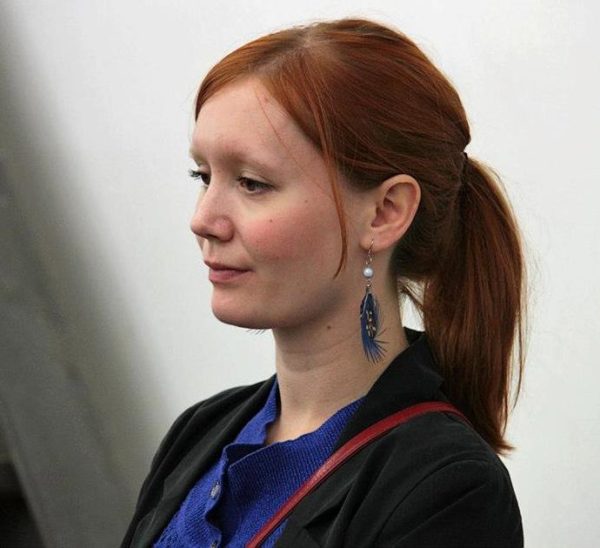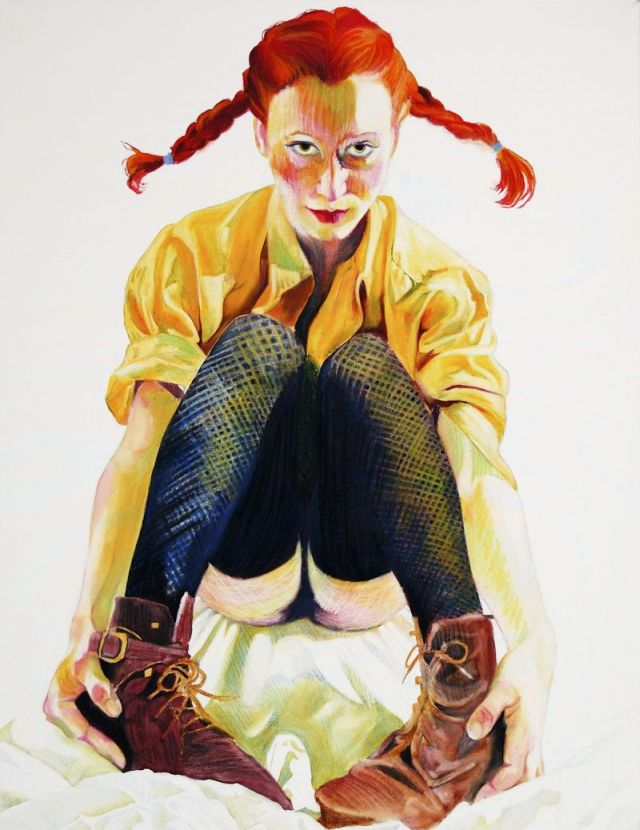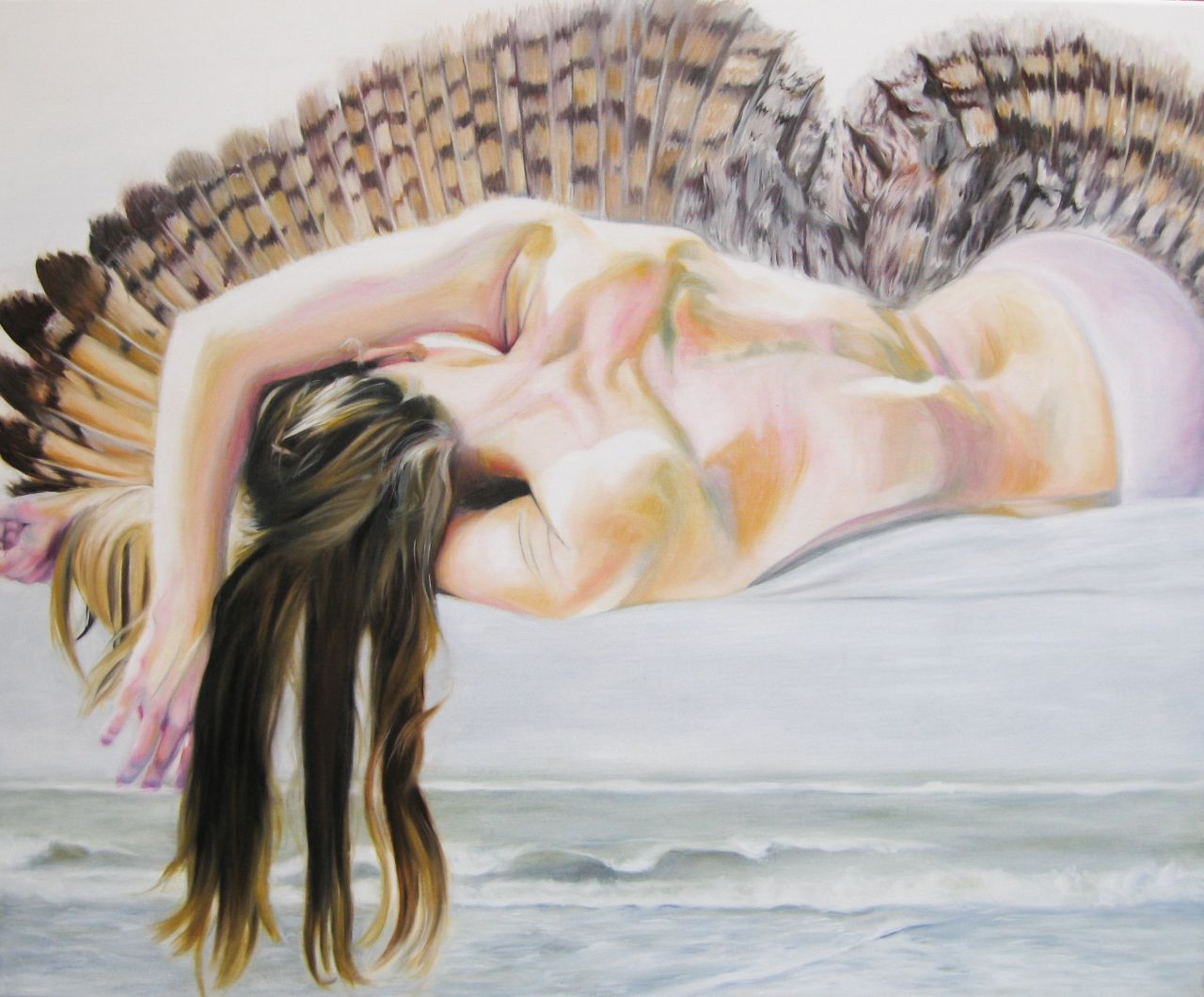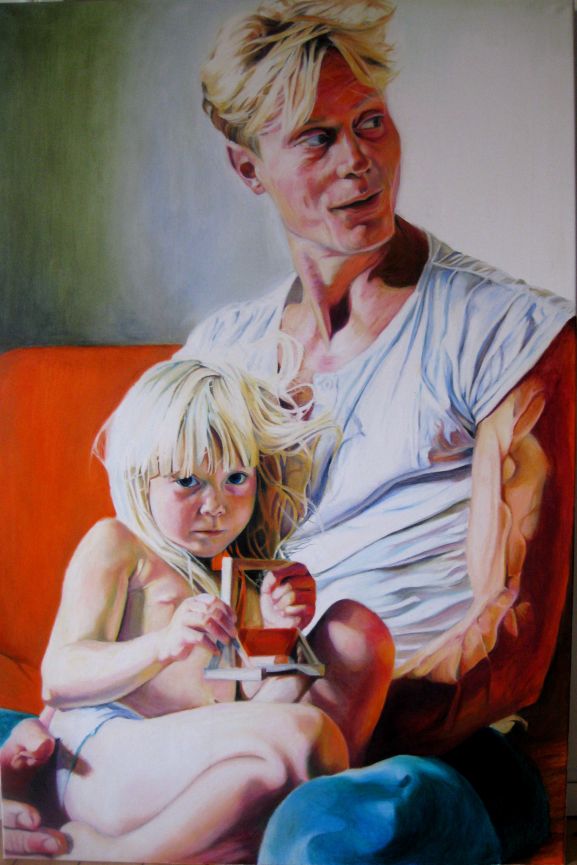Meet Myra Sjöberg the 29-year old Danish born artist who grew up in an artistic family. Her father, a Danish glassblower, is the owner of a shop in Denmark and mother is Swedish with a degree in fashion and tailoring. Myra lived in a town called Skagen which is located in the North of Denmark where two oceans meet. She described nature up there as really gorgeous and peaceful, a perfect place to raise a family; she thinks that’s the main reason that her parents decided to move up there was to raise her and an older brother.
Being exposed to a lots of imagination and creativity from a very early age helped develop her artistic skills such as drawing. Myra was always surrounded by her parents’ artistic friends, one whom later became her first art teacher.
From her drawings and sketches you can see the evolution on her work as an artist over the years. Her themes are mysterious and intimately beautiful with a soft touch of darkness through fine details, surprising us in each of her paintings.
For about 5 years, Myra now lives and works in Malmö, Sweden. It’s a relatively small city, close to Copenhagen where most of her exhibitions are displayed.
So enjoy this exclusive interview with this amazing artist and person. She shares her dreams, inspirations and thoughts. And please visit Myra Sjöberg official Facebook page.
RO: You are a self-taught artist; describe to us when you received your first calling as an artist?
MS: When I was 21 I attended an art school in Denmark and it was there that I painted my very first oil painting. I had previously mostly worked with water color – so this was a whole new medium for me, and I fell in love instantly. Working with oil color came very natural to me and that first experience really made me want to be an artist. The reason why I fell in love with painting is because of the magic you can create with texture and dimension. I love making something on a flat surface come to life – it makes me feel as if I’m some sort of Doctor Frankenstein.
RO: What did you draw/sketch or paint for the first time?
MS: My first oil painting was an impressionistic piece called Phinneas. It is a dark painting with an androgynous figure surrounded by a plume of feathers. I painted it in one night, so it was a very intense and awesome experience which really made me want to become an artist.
RO: How do the teachings of Carl Jung influence you in your art?
MS: I am very inspired by Carl Jung’s theories about the collective unconscious, archetypes and how we can gain knowledge about ourselves from the symbols in our dreams.
The collective unconscious is different from the individual unconscious in that it is something passed down to us that can’t be explained by social heritage. It consists of pre-existing forms known as archetypes. I try to use these archetypes in my paintings, such as my fairy tale series. I believe that when I use characters or archetypes which resonate in the collective unconscious it makes my artwork more relate-able to other people.
My art is very much derived from my own subconsciousness, I find that my best work is always based on instinct and I try not to over-think my ideas because it almost always makes them seem one dimensional and uninspired.
RO: Inspired by Sci-Fi, Fantasy and comic books, how did you apply these genres in your artwork?
MS: I work in a Sci-Fi and fantasy bookstore in Malmö and have always been very inspired by these genres. My favorite books growing up was The Lord of the Rings I read those books again and again. Tolkien was an expert at creating believable worlds that you could immerse yourself in completely and his descriptions of his world Middle Earth always painted such amazing pictures in my mind. I hope to one day be able to illustrate those books myself. All in all I guess it’s the world building within these genres that really inspires me.
RO: Do you have any favorite Sci-Fi comic books and movies – why?
MS: In science fiction you get to travel to the future or the past or far far away to another galaxy. The visuals of science fiction are so sublime, Blade Runner is a personal favorite of mine. I think it is the combination of film noir, futurism and oriental culture that really appeals to me, there’s such a nostalgic mood to the film.
China Mieville is another author I really like – I have only read a few of his books so far, but my boyfriend tells me that we share very similar ideas, i.e. I made an Amazon warrior whose armor is made of her own blood – apparently such warriors can also be found in Mieville’s book The Scar. Angela Carter and Neil Gaiman also come to mind – they both have a very poetic and yet simple and elegant language and I love the moods and emotions that their writing evokes in me. My fairy tale paintings (which were my first series of paintings and exhibition) was very much inspired by both of these authors.
Horror is another genre that I’m very inspired by, I really love the visuals and the balance between the beautiful and the grotesque. The filmmaker David Lynch is also one of my sources of inspiration and I love old black and white cinema such as The Cabinet of Dr Caligari and Metropolis. And last but not least I love comic books. My personal guru is Alan Moore, writer of Watchmen, V for Vendetta, Swamp Thing, Miracle Man and many more amazing books. His ideas and storytelling have really inspired me to make my own comic book, and I am currently in a collaboration with a writer about doing just that.
RO: You attended just one year of art school at Kunsthöjskolen Thorstedlund in Denmark; why did you stop?
MS: I attended Kunsthöjskolen Thorstedlund right after high school. I needed some time and some breathing room to figure out what I wanted to do with my life and höjskoler in Denmark is a great way to do that. It’s not really a formal education but more of a one year course in whatever you find interesting. I chose a school that had some great art programs and I had a really wonderful time. It was a great way to take a breather and explore whatever artistic interests I had to a more full extent. I met a lot of great people and teachers and decided to extend my stay from 6 months to a full year.
RO: How do you select your favorite subjects?
MS: I draw on my inspiration from my interests in literature, cinema and history. For instance, my latest series started with my fascination of werewolves – in particular female werewolves – from there I start collecting inspiration, books, movies and whatever else I can find.
I was very interested with the werewolf as a symbol of female strength which at the same time differs from the popular ideals of beauty and feminine qualities. I wanted to make a series of paintings which empowered women and showed the connection between the woman and the wolf.
The space that I’m going to exhibit in is just one small room, so this was something I had to take into consideration. I slowly started to evolve my idea into an exploration of the links between spirituality and nature. In this way, one idea became another – which is something that is often necessary when you work creatively. But I’m sure I will get to do my female werewolf series soon, as of now part of that idea is incorporated into the other.
As I’ve mentioned before I work primarily from my instincts and my subconscious. Whenever I begin a series of paintings it’s usually from a stream of consciousness. I’ll find a subject matter that interests me and the original idea will always expand.
RO: How do you define art?
MS: Oscar Wilde said it perfectly in the preface to The Picture of Dorian Gray:
“The artist is the creator of beautiful things. The only excuse for making a useless thing is that one admires it intensely. All art is quite useless.”
In my opinion art is not something we as a species need to survive but it is something that makes life worth living. A great civilization should be judged not only on how it treats it’s citizens but also on the significance that it places on artistic expression. Art is the voice of the people, it is a Litmus test indicating whatever is going on in society and an expression of the human state of being.
RO: Who did you admire most when you started painting? And now? Are there any artist whose work you enjoy today?
MS: When I was younger the first painters that I gravitated towards were Frida Kahlo, Kandinsky, John Waterhouse, Nicholas Kalmakoff, Gaudi, Chagall and the Swedish illustrator John Bauer. I still love all of these artists but now I also love Egon Schiele, Vermeer, Frank Frazetta, Milo Manara, Enki Bilal, Moebius, Georg Gudni, Dave Mckean, Arthur Rackham, Francis Bacon, Edward Hopper, Louise Bourgeois, Jackson Pollock , James Jean and Filmmakers such as David Lynch, Sally Potter, Jane Champion, Quentin Tarrantino, Ridley Scott, Stanley Kubrick and Jim Jarmusch.
I consider my work to be very cinematic and I love working with the illusion that my paintings are on the verge of coming to life – I think this trait in particular is inspired by my love of cinema and the theater.
RO: Tell us about your workspace and your creative process? Does it matter where you live as an artist?
MS: Right now I live and work in Malmö, Sweden. I share a studio space in a basement with 7 other artists. I don’t have a lot of space, but I’m very fortunate that the rent is very affordable. The company that owns our apartment building have started a great project in which they create studios for local artists in empty locales in their buildings around town. Of course I often wish that I had more space to create some of my bigger paintings, but it’s really great to have a studio either way, because it’s a place away from home where I’m not distracted by everyday trivialities and where I’m able to meet and work alongside other creative people. I don’t think that you need to have a studio in order to be creative. Having restrictions can often force you to find creative solutions to problems. But at the same time I feel that I’m constantly growing and evolving as an artist and part of that process is figuring out how I work in the most optimal way. Having a studio has certainly helped me become more focused and I like the idea of ‘going to work’ every day.
RO: What are the best and the worst part of being a full time, working artist?
MS: The absolute best part of being a full time artist is that I have full control about how I want to plan my workday and what I want to create. I love the process of beginning a new project or working on an exhibition – the feeling that the work is all mine and that I don’t have to take anyone else’s opinion into consideration is both a wonderfully fulfilling and very liberating experience but it also means that I’m fully responsible for the work process and if I don’t meet a deadline or live up to my own expectations there is no one to blame but myself.
RO: What other interest do you have outside of art? And what dreams do you still wish to fulfill?
MS: My dream has always only been to become a respected artist among my peers and to hopefully be able to make a living doing what I love. I have a few goals that I’m working on making a reality such as creating a comic book, illustrating a children’s book and maybe even becoming a writer one day. I’d also love doing an exhibition abroad and I definitely want to travel more. I think it’s important to have goals and dreams – but I think it’s even more important to try to make them into a reality.
RO: What’s the best lesson you’ve learned along the way? And what’s been your best decision?
MS: The best lesson I’ve learned along the way is that every moment is a new beginning and also to trust my gut instinct. Working as an artist means being in a state of constant fragility because the work you do is so closely connected to your confidence and sense of self worth at the same time it’s very fulfilling work that lets you grow as a person in a very spiritual way. I try to focus on this part of the process and not so much the end result of my creative endeavors – it’s all about the journey, not the destination. My best decision has definitely been to start taking myself seriously as an artist. The big change came when I quit my full time restaurant job and started calling myself an artist instead of a ‘waitress who loved painting’.
RO: What are your goals as an artist? How do you see yourself progressing? Or does this matter?
MS: My goal as an artist is simply to keep evolving and growing with my work. I used to have aspirations of being a famous artist but now it’s more than enough to simply enjoy my creative process and to be able to create without the added pressure that my work has to sell. I’ve always felt that as long as I’m in love with what I do – then someone, somewhere out must feel the same way and appreciate my passion and the beauty and truth in my work.
RO: Which five words best describe you?
MS: Creative, dreamer, shy, stubborn, silly.
RO: Are there any new or upcoming project(s) you are working on that you’d like to share with us?
MS: At the moment I’m working on several projects, one is a comic book, another is a children’s book, then there’s a huge mural that I’m doing together with another artist from my studio. My next big series will most likely be an exploration of female goddesses and how all religion stems from the same archetypes. Also I might do another female werewolf inspired series.
RO: Are there any other thoughts or anything else you would like to share?
MS: I think art today is a very relative term. You can argue that anything is art, if you are using the right arguments and have a way with words. In my opinion there is nothing wrong with this. The real question is; what is good art and what is not. The only person who can really answer this is oneself. The only purpose that I have as an artist is to communicate my own truth and learn and grow in this constant stream of thought and revelation. Hopefully my artwork becomes a kind of mirror that people can see something of themselves in and we can share this journey of discovery and wonder.
PS: All images here are used with permission. Please do not distribute without first contacting the artist.







Ah ha! I did it!
Thank you so much for the help, Rhonya, and for this great post.
Truly such a talented individual!
It does always inspire me to read or hear about how an artist got their wings, meaning how they got started and developed their skills. I can’t help but feel that I couldn’t possibly catch up to their level, but then again, who’s competing, right 😉
It’s about the enjoyment and exploration …
Cheers,
=) Detlev
PS: If you’d like to comment and are at least a little confused as to how to do that, take a peek at the Help page and it’ll walk you through a few quick steps.